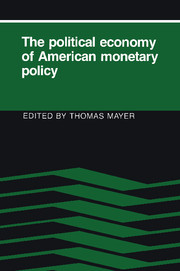Book contents
- Frontmatter
- Contents
- Preface
- List of contributors
- 1 Introduction
- 2 Studying the Fed: toward a broader public-choice perspective
- 3 The Federal Reserve reaction function: a specification search
- 4 Corporate profitability as a determinant of restrictive monetary policy: estimates for the postwar United States
- 5 Federal Reserve behavior since 1980: a financial-market perspective
- 6 The Federal Reserve and its institutional environment: a review
- 7 The political economy of monetary policy
- 8 Political monetary cycles
- 9 Congress and the Fed: why the dog does not bark in the night
- 10 The Federal Reserve as a political power
- 11 Monetary policy and political economy: the Federal Reserve and the Bank of Japan
- 12 A positive analysis of the policy-making process at the Federal Reserve
- 13 A theory of FOMC dissent voting with evidence from the time series
- 14 Explaining FOMC members' votes
- 15 Fed behavior and X-efficiency theory: toward a general framework
- 16 Minimizing regret: cognitive dissonance as an explanation of FOMC behavior
- 17 The discount window
- 18 Leaning against the wind: the behavior of the money stock in recession and recovery, 1953–8
- 19 Bureaucratic self-interest as an obstacle to monetary reform
- Index
19 - Bureaucratic self-interest as an obstacle to monetary reform
Published online by Cambridge University Press: 06 July 2010
- Frontmatter
- Contents
- Preface
- List of contributors
- 1 Introduction
- 2 Studying the Fed: toward a broader public-choice perspective
- 3 The Federal Reserve reaction function: a specification search
- 4 Corporate profitability as a determinant of restrictive monetary policy: estimates for the postwar United States
- 5 Federal Reserve behavior since 1980: a financial-market perspective
- 6 The Federal Reserve and its institutional environment: a review
- 7 The political economy of monetary policy
- 8 Political monetary cycles
- 9 Congress and the Fed: why the dog does not bark in the night
- 10 The Federal Reserve as a political power
- 11 Monetary policy and political economy: the Federal Reserve and the Bank of Japan
- 12 A positive analysis of the policy-making process at the Federal Reserve
- 13 A theory of FOMC dissent voting with evidence from the time series
- 14 Explaining FOMC members' votes
- 15 Fed behavior and X-efficiency theory: toward a general framework
- 16 Minimizing regret: cognitive dissonance as an explanation of FOMC behavior
- 17 The discount window
- 18 Leaning against the wind: the behavior of the money stock in recession and recovery, 1953–8
- 19 Bureaucratic self-interest as an obstacle to monetary reform
- Index
Summary
To appreciate the textures and aromas of exquisitely flavored foods and sauces, one needs to cultivate an educated palate. Similarly, to appreciate the Federal Reserve's complex role in the evolution of U.S. monetary and regulatory policies and policy structures, one needs to cultivate an informed political-economic perspective on the Fed's evolving bureaucratic interest and on the various battles for turf in which this agency becomes involved.
Top Federal Reserve officials portray monetary stabilization and financial regulation as multidimensional services that, because of potentially valuable informational spillovers, are best produced together and run by their agency. Implicit in that conception is a presumption that Fed officials operate a politically inert and farsighted enterprise, passionately dedicated to the goals of economic efficiency and macroeconomic stability. Far from acquiescing in that presumption, this chapter emphasizes that efforts to protect the Fed's bureaucratic self-interest introduce myopia and distributional politics into Fed policy decisions and public statements.
The analysis offered here is intended as an antidote to traditional writings on the U.S. Federal Reserve System. Most macroeconomists portray the Fed as a politically inactive institution whose virtually only business is to use its “big three” policy weapons (open-market operations, reserve requirements, and the discount rate) to fight the excesses of the business cycle. This chapter depicts the Fed as a politically sensitive bureaucracy whose marketing activity and capacity for financing continuing clientele subsidies are at least as important as its production of stabilization services.
- Type
- Chapter
- Information
- The Political Economy of American Monetary Policy , pp. 281 - 296Publisher: Cambridge University PressPrint publication year: 1990
- 3
- Cited by



